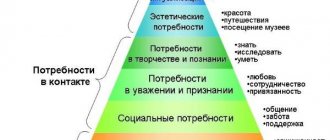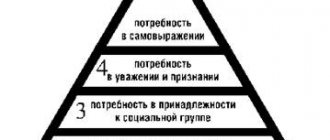What is motivation?
Let's start right away with an example: let's say you want to buy a car (a fur coat, travel around the world, etc., choose the one you need). Realizing that you don’t have a rich American grandfather ready to leave you an inheritance, you understand that the only way is to earn the required amount of money.
You find yourself a part-time job in addition to your main job, try to climb up the career ladder at your main place of employment so that your salary can be increased. That is, you make efforts directed in a certain vector, and you do not do it occasionally, but persistently and systematically .
The motive that motivates you to work is the coveted car (or another elusive goal). Consequently, you motivate yourself to work valiantly to complete the task at hand.
Motivation is a psychological process that encourages a person to take any action to achieve a certain goal.
Wikipedia defines motivation as follows:
Moreover, this process can be conscious, as in the example above, or at the subconscious level. An example of such motivation: you are thirsty and go to a source of water (to a tap in the kitchen, to a spring in the forest, to a store). At the same time, you do not consciously set yourself up to make the path to water; you make this decision at the subconscious level.
Scientists engaged in research in the field of psychology do not agree on the definition of motivation.
Some argue that motivation is an incentive to activity + activity itself, others say that motivation is only a set of motives that are catalysts for human activity.
Let’s not delve into scientific depths; let’s understand the theories of motivation using everyday examples.
Motivation for a fulfilling life
According to many of us, the key reasons for people's failure is a lack of willpower or time. WITH
From an expert point of view, such reasons only have a slight impact on achieving success; the main thing is that they do not have decent motivations, as well as aspirations to live in a new, better way.
There is a “formula” for motivation, which should include the following components:
- the process should bring pleasure to a person - it involves choosing one’s business with both the mind and the heart. This activity may include experiments, but the main thing is to get moral satisfaction from it. We are talking about work that you enjoy, and not only provides material well-being;
- we need decent performance results - this is another side of this issue. You can enjoy the process, but not receive a decent reward. This causes frustration, and these workers may simply burn out and lose interest in their work. Life can become a process of survival. Thus, being satisfied with the fruits of one's work is an important part of a harmonious existence. And naturally, the result of work motivates for further achievements and new goals;
- a cherished dream, a goal - another element of the formula that ensures a happy, fulfilling life. Without this, it is impossible to achieve harmony and fulfill the destiny that every person has. Such a goal could be teaching other people, producing a much-needed medicine or product, building an important highway, creating masterpieces of fine art, etc. These goals bring the necessary changes to the existence of the world. And in turn they motivate to action and self-expression. And each of us must remember that doing the work we love, doing what we love, we live every day for a reason. We change the world for the better, working for the benefit of ourselves and others.
Thus, having all three components of this formula, we are actually capable of a lot.
Types of motivations
There are the following types of motivations:
- lumpen - where there is a low level of responsibility, remuneration, work performance, low qualifications without a desire to improve them, lack of initiative, activity and the expenditure of minimal effort to achieve the goal;
- instrumental – assumes that the main value is the reward for the work done. Material reward can be in monetary terms or in the form of material benefits. That is, workers pursue the main goal - to obtain a means of subsistence, and moral satisfaction does not play a significant role for them;
- professional – involves getting a chance to realize yourself, demonstrate skills, experience and theoretical ones, as well as your interest in doing meaningful work, showing yourself as a real specialist in your field. An employee cares about the opinions of others about his qualifications and competence in certain matters. It is important for them to show decent respect for their work from other people;
- patriotic - where there is a person’s devoted attitude to what he does, to his colleagues at work, to public interests, to his homeland. That is, in this case there are high moral, ideological, religious considerations. The employee values the result of collective work, but with due recognition of his participation, which can be expressed in remuneration, evaluation of an intangible nature;
- master's - involves performing the functionality at maximum efficiency, but without insisting on a high level of meaningful work or high remuneration. In most cases, employees voluntarily take the burden of responsibility onto their own shoulders, and do not want to be controlled. It is important for them to be free in their decisions and actions.
Read our article “Breathing practices: characteristic features of basic techniques.”
Why do you need to motivate a person?
The natural need for well-being that is inherent in each of us is motivation. There is a desire for growth, development, and functioning at full strength. What matters is prosperity, self-expression, self-knowledge and recognition by other people of their competence. And these aspirations appear almost from birth. However, success and prosperity, especially in professional activities, cannot come on its own.
Personal growth and social interaction are not always a guarantee of a positive outcome in this situation. Successfully achieving your goals at work requires nourishment and careful attitude. Our business and work can both help to flourish and create obstacles to well-being.
There is an opinion that standard motivation loses its effectiveness, further suppressing the potential inherent in employees. If we look at the facts, it turns out that standard methods of motivation more often suppress than encourage the potential inherent in employees. Therefore, the question of new types of motivation remains open.
Motivation is a hormonal process
Motivation is a psychophysiological process. What does it mean? Human psycho-emotional reactions are inextricably linked with physiology. The hormone dopamine produced by our body is also called the pleasure hormone . Did something → enjoyed it.
This happens on a subconscious level - the hormone is produced at the moment of reward. Its effect on the body is reminiscent of training: stand on your hind legs - take a piece of sugar.
The process of motivation is also “tied” to the effect of dopamine on the central nervous system. No matter how we motivate ourselves, if there is little dopamine in the body, it will be very difficult to achieve success.
Dopamine hormone levels can be increased in 2 ways:
- Proper nutrition (meat, fish, green vegetables, strawberries).
- Formation of an optimal motivation system: “ from simple to complex .” First you need to set small goals and achieve them, and only then achieve something more significant.
Intrinsic motivation
A small child is constantly trying or exploring something. This is really important and interesting to him. A person works not for a salary, but because of what he loves. These are examples of intrinsic motivation. As already mentioned, it does not depend on external factors and the environment. The very content of the activity encourages a person to engage in it.
What can you use as internal motivation? The opportunity for personal growth, a sense of need, self-affirmation, the implementation of ideas, creativity, the need for communication, the fulfillment of dreams.
Intrinsic motivation of an employee is when he views his work as a paid hobby. Perhaps, if not all, then many people would like to strive for this.
It is much more effective to use both types of motivation. The main thing is to maintain balance and balance between them.
Main types of motivation
The classification of this process is very diverse. American psychologist A. Maslow, in his work published in 1954, classified all types of motivation that guide a person according to their degree of significance .
He visually presented them in the form of a pyramid of needs, where fundamental motives are at the base, and above them are in descending order of importance in a person’s life.
Conventionally, we can distinguish several enlarged types of motives that encourage action.
- External and internal:
- external - are outside the scope of activity.
These include: a sense of duty, responsibility to society (what is this?) or a person, the desire to receive approval. Example: a student has been given a public assignment, he strives to fulfill it as well as possible, guided by a sense of duty, in order not to let his comrades down; - internal – are directly related to the object of activity, determined by the individual’s interest in the process and result of a specific activity.
Example: an athlete strives to win competitions, he trains hard, therefore, on the way to achieving his goal, he is interested in increasing the effectiveness of his training.It is worth noting that motivation in sports is no less important than the presence of super-outstanding athletic abilities. A person with average physical characteristics and powerful motivation will achieve more in the sports field than a brilliant athlete without decent motivation to win.
The video shows an example of external and internal motivation for losing weight (losing weight not because you “have to”, but because you “want”:
- acting – determining human behavior at the moment;
Example: a boss promised his employee a promotion if he completed a certain stage of work ahead of schedule. For an employee, the motive of prestige (increased labor status) moves from the category of potential motivational motives to the category of actual (acting) ones.
Extrinsic motivation
The employees were promised a bonus and they started working faster. They established fines and rules, people began to focus on them, whether they liked it or not. A suddenly appearing thundercloud makes you run home faster. The criminal pointed a gun at you and demanded money - you will immediately give up your wallet.
These are all examples of extrinsic motivation. As already mentioned, it encourages action through prevailing circumstances or incentives. In another way, we can say that these are achievements in the surrounding society. Of course, internal motivation is much more effective. However, this type of influence has a better effect on individuals.
So, what methods are suitable as external motivation? Career growth, big salary, prestigious things (apartment, house, car), status, opportunity to travel, recognition.
Extrinsic motivation can constantly change. Yesterday you had to earn money to feed your family, and tomorrow you will need money for a new apartment, car or children’s education. The most obvious and classic example of such motivation is the fairy tale about the goldfish and the fisherman.
What motives can make a person act?
There are many motives that can become the basis for inducing a person to action. Next, we will consider the most common of them.
Imitation of an idol
Many people, especially at a young age, choose a role model for . Such an object could be a relative, a media person, including a pop or rock star.
A person who identifies himself with another personality (we are not considering the pathology of mental health) strives to develop, to reach the level of his idol. This is a positive aspect of this type of motivation, thus the young person becomes part of a certain society.
But there is also a downside: sometimes a person tries to copy the negative aspects of his idol’s personality, although they are often only part of the invented image.
Motivation for success (self-affirmation)
This is the most positive motive for achieving victory. Thanks to motivation for success, we strive to become better, learn new things, and achieve certain goals. “I have to be the best!” - such a doctrine (what is it?) becomes a priority for the athlete before the start.
“I have to write the best essay!” — this is what the student is guided by. In the above examples, the motive of self-affirmation comes to the fore.
Career, power - a very common motive for action
Since ancient times, power has been one of the most powerful motives for overcoming many obstacles.
The problem is that if this aspect becomes a priority, then everything else fades into the background. Such a person, having achieved a dominant position, certainly causes damage to the society of which he has become the leader.
For example, for an employee who, with great difficulty, achieved the position of head of a department and became the leader of dozens of people, the priority of his future activities will be to keep the resulting power in his hands. Meanwhile, the immediate tasks being solved by the team entrusted to him will seem to him not so significant. As a result, overall performance will suffer.
Self-development
This reason for action is not always actualized in people; often another motivation comes to the fore. People are inert by nature, so the main motives for moving forward are those aimed at improving the quality of personal life support.
Thus, a person who has set the goal of earning money to buy an apartment will devote all his time to work. He will not learn English during this period in order to read Shakespeare in the original, because the motive of self-development is currently at the bottom of his list of life goals. To actualize the desire for self-development, some kind of external push is needed, the attraction of other motivating factors.
People involved in education and mentoring should remember the need for an external impetus to trigger It is useless to tell poor student Ivanov that he will need the results of his studies in life. Until the unfortunate student has other motivating factors (other than self-development), you should not expect good studies from him.
Social (prosocial) motivation
All people are social to one degree or another, because they live in society and work in a team. It is impossible to live in society and be cut off from it; we all (whether we like it or not) are subject to general norms and rules. If a person has prosocial motives as a priority, then such an individual has the most developed sense of duty and responsibility to other members of society.
As a life hack (what is this?) for personnel officers of government agencies: if, when appointing officials to positions, a psychological examination was carried out to identify the priority motivating factor, then the contingent of our leaders would be entirely “white and fluffy”, and corruption would be forgotten forever.
Negative motivation (fear)
“If you don’t eat the soup, you won’t get candy” is the simplest example of negative motivation. In this case, the motive is fear of punishment, and this is a powerful catalyst for taking any action. An important aspect of negative motivation is the belief that punishment is inevitable.
Corporation owners have long understood this and motivate their employees to work harder and better through fear. According to their patterns, people are taught from school to take out loans and mortgages. As a result , a person is overmotivated to keep his existing job, because otherwise he will lose everything.
Another example. As soon as the parents threaten a poor student with deprivation of walks, computer toys, etc. for poor studies, he will immediately begin to do his homework and get well-deserved good grades. But as soon as the parents relax their attention and do not remind them about the sanctions, he immediately slides back to his favorite “twos”.
Depending on the situation, punishment can be in the form of verbal condemnation, financial fines, social isolation, physical force, or imprisonment. So, some people do not steal because they were raised that way, while others do so because theft can be punishable by criminal penalties. The motivation is different - the result is the same.
Research in the behavioral sciences has demonstrated the failure of a purely economic approach.
Managers learned that motivation, i.e. the creation of an internal drive to action is the result of a complex set of needs that are constantly changing. We now understand that in order to motivate his employees effectively, a manager must determine what those needs actually are and provide a way for employees to satisfy those needs through good performance. [p.75] The explanation of this situation in the broad sense of the word is based on the theory of motivation. Motivation is defined as the force that motivates action. Motive is an internal urge, impulse or intention that causes a person to do something or act in a certain way. [p.441]
Substantive ones are based on the fact that there are internal motivations that force a person to act. [p.122]
Let's start by recognizing the obvious fact that people's economic activity is carried out in the name of fulfilling needs - obtaining various benefits, economic and non-economic, material and intangible. Awareness of needs generates motivation - an internal urge to action. From the point of view of modern economic theory, economic action is motivated by interests. This means that when a stimulus arises in the form of a natural or monetary benefit, a person calculates the possible consequences of the intended action. First of all, two factors are assessed: the relative utility of the benefit received and the amount of costs necessary to obtain this benefit. In this case, it is believed that the interest of an economic entity lies in maximizing utility and/or minimizing costs to obtain a benefit or set of benefits. [p.56]
Labor is a process characterized by the expenditure of human time and energy aimed at transforming natural resources into material, social, intellectual, aesthetic and spiritual benefits. Such activities can be carried out either under coercion (administrative, economic), or under internal motivation, or both. [p.131]
Content theories of motivation are based on the identification of internal drives, called needs, that force people to act in certain ways. At the same time, there is no single identification of needs recognized by everyone. [p.112]
Every economic activity of people is carried out, ultimately, in the name of realizing their needs, which can be defined as the necessity and possibility of acquiring, preserving and using various benefits - economic and non-economic, material and intangible. If a certain good turns out to be significant and desirable for a person, then it turns into a stimulus, i.e. updated need. When the impulse of striving for this object passes through a person’s consciousness, the stimulus develops into a motive - an internal urge to action. [p.25]
While lower needs act as a direct, unconditional incentive, i.e. “push” behavior without an intermediary motive (try not to breathe, no special internal motivation is required here), the needs of higher levels have many options for implementation, so in this case one cannot do without, for example, the concept of an ideal. Here even the definition is almost identical: ideal - this is an idea (maybe unattainable) of the future that stimulates the activity of the individual. [p.108]
With 10-21 points, your desire to become a manager is dictated to a greater extent by advertising and fashion than by internal motivations, but if your intention is firm, then in order to become a good manager. You will need significant socio-psychological preparation. [p.251]
Motivation is to ensure that organizational members perform work as planned. Previously, it was believed that motivation was the offer of appropriate monetary rewards in exchange for effort. In modern conditions, motivation is considered in the context of creating an internal urge to action. It is the result of a complex set of needs that are constantly changing. In order to motivate, the manager must determine what these needs actually are and provide the employee with a way to satisfy the needs through good work. [p.58]
Work motivation is a state of internal motivation to work to achieve the personal goals of the employee and the organization. [p.102]
By studying the totality of external and internal motivations for work, one can answer the question of why a given person acts this way and not otherwise. [p.112]
A systematic approach to the labor potential of an employee considers and evaluates professionalism, taking into account the importance of what motivates a person in the profession, what value orientations he comes from, why he is engaged in this work, what internal resources he voluntarily and out of internal motivation invests in his work. [p.69]
Among examples of active labor behavior, it makes sense to highlight proactive behavior, which is based on action based on internal motivation and the desire to learn from the experience, achievements, innovative techniques and work methods of colleagues. An enterprising person is an initiator, and therefore is diligent, systematically improves, adopts advanced experience and perfect working methods. Gradually, such an employee begins to gain an advantage even over more capable, creative colleagues, if the latter neglect the desire for new forms of activity. Initiative behavior is associated with many difficulties that the pioneer has to overcome and at the same time unlearn a lot. [p.120]
Activity is a specific type of human activity aimed at knowledge and creative transformation of the surrounding world, including oneself and the conditions of one’s existence. Activity is characterized by the concepts of motives, goals, objects, structure, and means. Motive is a set of internal motivations for activity, based mainly on [p.69]
There are internal (the incentive to activity is determined by the personal goals of the subject - needs, interests, values) and external motivation (the incentive to activity is determined by goals set from the outside, through coercion, an agreement to exchange the result of the employee’s activity for benefits, psychological influence for the formation of the same goals, the same as for an entrepreneur). It is advisable to call external motivation motivation (stimulation). [p.70]
In the new situation, it is necessary for a leader to be able to conduct a qualified analysis of the psychological aspect of economic and organizational, and not just social, problems. Moreover, it is desirable that the qualities of a leader are perceived by others as a natural manifestation of his nature and character. When the rules of communication with subordinates that are obligatory for him are observed not out of internal motivation, but under the pressure of circumstances, then those around him feel this very well, and no decorum is able to compensate for the lack of sincerity on his part. [p.129]
Enterprises of all forms of ownership must themselves experience strong internal motivations for scientific and technological progress. It is necessary to remember the leading role of production itself, its needs for the technical re-equipment of enterprises and increasing their efficiency. [p.24]
In equilibrium, the market is balanced. Neither sellers nor buyers have internal incentives to violate it. On the contrary, at any price other than the equilibrium price, the market is not balanced. Buyers or sellers have a desire to change the market situation. [p.21]
In equilibrium, the market is balanced. Neither sellers nor buyers have internal incentives to violate it. On the contrary, at any other price that differs from the equilibrium price, the market turns out to be unbalanced. Buyers or sellers have a desire to change the market situation. There are two possible cases here [p.22]
The motivation stage is intended to express motives, internal motivations of the individual and the implementation of official (production) duties. [p.217]
Prerequisites for the formation of internal motivations for proactive creative work [p.231]
Khrushchev's memories of his first meetings with the Chinese confirm and illustrate the limitations of his horizons, as well as his primitive, stereotypical ideas about the East. And it was not easy for Mao to come to terms with the role of a grateful junior partner, especially when the unpredictable Khrushchev became his Soviet mentor. The latter clearly went overboard in demonstrating his generosity. In addition, Khrushchev allowed himself to make decisions that no one in the Soviet leadership had ever made. His behavior was contradictory, irrational and suicidal. He never did what the situation dictated, allowed or inspired by culture, but was guided only by internal motives. [p.93]
It is very useful if the qualities of a leader are perceived by others as a natural manifestation of his nature. When a leader observes the mandatory rules for treating his subordinates not out of internal motivation, but under the pressure of circumstances, then those around him feel this very well, and no decorum can compensate for the lack of sincerity on his part. [p.116]
The need for reading is a complex social-personal phenomenon, which objectively represents a social necessity, and is subjectively experienced by a person as internal motivations. [p.70]
Emerging reading interests can be recognized by people earlier than the need for reading, and serve as an intermediate stage in the process of transforming social needs into personal ones. At the same time, reader interests are true when they correspond to the objective need for reading, and false if they contradict it. False interests are characterized by the fact that people's internal motivations for reading are a distorted reflection of the actual needs of a social group. Let's say a group of readers is interested in low-quality detective fiction, while objectively this group needs to read socio-political or popular science literature. It is especially important to distinguish between true and false interests in the socio-psychological analysis of the reading of the masses. For example, in capitalist countries, false reading interests are fanned by the press and a stream of low-quality literature that savors the details of crimes. [p.75]
What do we do to hide our inner impulses and needs? We try to create our image as a person who feels great, has no problems, controls himself and, of course, can do a lot, if not everything. We want to appear independent and self-reliant. But let's see how this turns out. [p.369]
Alienation of labor was reduced by Marx to four main principles. characteristics 1) there is an alienation of the product of the worker’s labor from himself, ... the worker’s attitude to the product of labor, as to an object alien and dominating over him..., attitude to the sensory external world, to objects of nature, as to an alien world, hostilely opposing him (there same, p. 91) 2) the labor of the worker is not voluntary, performed but by internal motivation; it represents alienated labor, which acts as forced, forced labor (see ibid., p. 90) 3) the totality of societies, forces, just like the forces of nature, they are separated from the worker and oppose him, as a result of which his life activity turns ... only into a means for maintaining his existence (ibid., p. 93). This reveals the extreme impoverishment of the human essence, the suppression of the needs of the worker (see ibid., p. 133) 4) there is an atomization of society, the alienation of people from each other - as a consequence of the fact that each of them is alienated from his own human essence. [p.554]
Motivated activity is a person’s actions determined by internal motivations, aimed at achieving one’s own goals and realizing one’s interests. In this type of activity, the employee himself determines the form and extent of his actions, depending on internal motivations and environmental conditions. [p.64]
CONTENT THEORIES OF MOTIVATION are based on the identification of those internal motivations (called needs) that make people act in one way and not another. In this regard, the work of Abraham Maslow, David McClelland and Frederick Herzberg will be described. More modern PROCESS THEORIES OF MOTIVATION are based primarily on how people behave based on their perceptions and cognitions. The main process theories we will look at are expectancy theory, equity theory, and the Porter-Lawler model of motivation. [p.362]
APATHY (from the Greek apatheia - dispassion) - 1) an indifferent, indifferent attitude towards the environment, a state in which internal motivations, interests, emotional reactions are reduced or completely lost 2) one of the basic concepts of the ethics of Stoicism, complete freedom of the soul from passions and affects. [p.413]
Content theories of motivation are based on the identification of internal drives, called needs, that make people act in one way and not another. The works of A. Maslow, D. McClelland and F. Herzberg are devoted to this. [p.211]
MOTIVATION (from the Greek motif, from the Latin moveo - I move) - external or internal motivation of an economic entity to activity in order to achieve any goals, the presence of interest in such activity and methods of initiating and motivating it. [p.186]
Integrated (a combination of values generated by motivation from outside and inside). This is a kind of decoration, the upper superstructure above the hierarchical pyramid of the VALS classification is a small group of people called integrated. This is that rare category of people who manage to combine incompatible things and combine all values in their way of life. They seem to combine the strength of people motivated from without with the sophistication and sensitivity of those whose lifestyle is based on internal motivation. [p.222]
Partial resolution does not eradicate the causes of the conflict. As a rule, it expresses only an external change in conflict behavior while maintaining the internal motivation to continue the confrontation. The restraining factors are either strong-willed arguments coming from reason, or the sanction of an outside force influencing the participants in the conflict. The measures taken are aimed at convincing or forcing the conflicting parties to stop hostile actions, to exclude anyone’s defeat, and to point out means to promote mutual understanding. [p.227]
The economic world of F. Perroux rests on inequality as the fundamental principle of economic life. He believes that in the social and economic system of modern capitalist society there are no internal motivations that would push this system to the same [p.90]
The influence of motivating factors on a person
Motivation is a powerful tool for achieving certain goals in all spheres of human existence. Do you want to achieve something? Find the right motive that will move you forward.
For example, an excellent motivation for losing weight is health improvement, the envy of girlfriends (yes, even such a motive can be very effective), gaining new followers on Instagram, increased attention from young people.
Do you want your subordinates to complete their work ahead of schedule? Motivating staff with the promise of a bonus (encouragement, appointment to a responsible position) is most effective.
Effective motivations change at different periods of his life: previously relevant motives become potential and vice versa.
A little man goes to first grade, he doesn’t really want to study, but his parents force him to go to school, check his lessons, etc. There is negative motivation. Having matured, the student understands that without passing the Unified State Exam perfectly, he will not be able to enter Moscow State University and will not become, for example, a diplomat. A different motivation is immediately updated, and conscientious study becomes the meaning of life for the coming years.
Self-motivation is the engine of progress
For meaningful movement, it is important to know where to come from and where to go, as well as to have a great desire. That is, self-motivation is necessary. How to achieve it? Follow the techniques and rules listed below:
- Set yourself only achievable goals. Only then will there be a desire to achieve them.
- Break big goals into small tasks.
- Keep a diary of achievements.
- Constantly reward yourself with rewards for completed tasks.
- Try to use as little criticism as possible.
- Look for like-minded people in your business.
- Try to compete with others and become the best.
- Surround yourself only with positive and goal-oriented people.
- Read books and watch movies that motivate you.
Try to implement, if not all, then at least a few points, and you will definitely have a desire to get down to business! Remember that it is important to use positive and negative factors, internal and external motivation in balance in order to achieve a good result.
How to strengthen the effect of motivation
As a rule, human behavior is simultaneously influenced by several motives. And the more there are, the higher the likelihood that the goal will be achieved.
Example: two athletes of the same level are preparing for important competitions. One of them dreams of winning and receiving the prize fund. The other, in addition to money, wants to bring extra points to his team and prove that he is the best in this sport.
We can say with confidence that the second athlete will win, because under the same initial conditions he has a higher motivational level.
There are only 2 ways to increase your motivation level:
- Increasing the number of motives prompting action.
- Updating motivating factors for a specific situation.
Well, you can also listen to the advice given in this video :
Motivating others
People who are motivated by upward striving do not pay attention to comfort. They are driven by the pursuit of personal interests and organizational goals. Employees who are driven by punishment will not do things that take them out of their comfort zone.
It is very important to take into account external positive factors. These are money, reliability, conditions and safety. Internal positive factors play an equally important role. These are achievement, growth, empowerment, recognition and responsibility. Only the right combination of these factors will give job satisfaction. In their absence, work becomes hateful and unbearable. In this regard, the motivation of students or schoolchildren is no different. It is important that internal learning motivation prevails.










